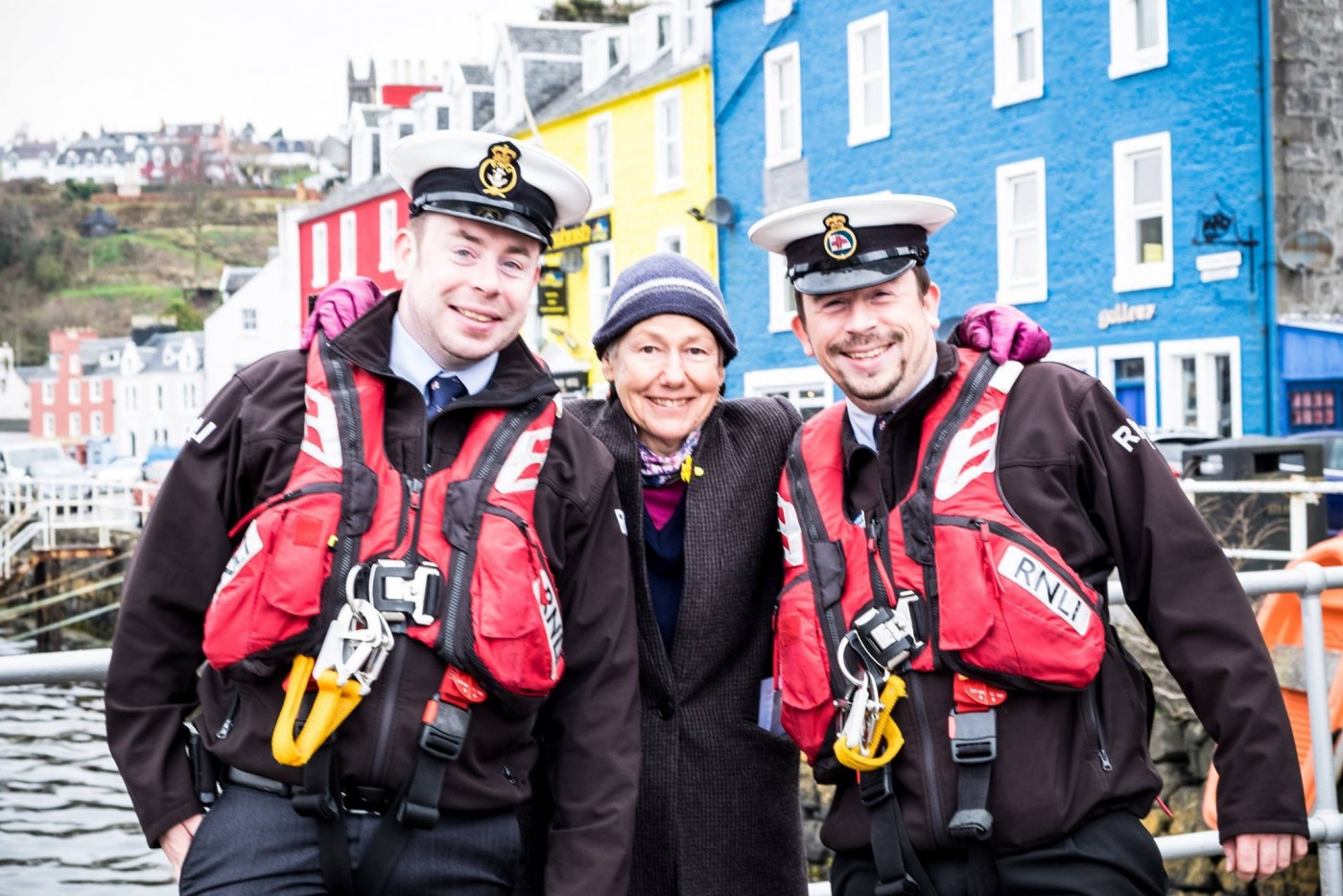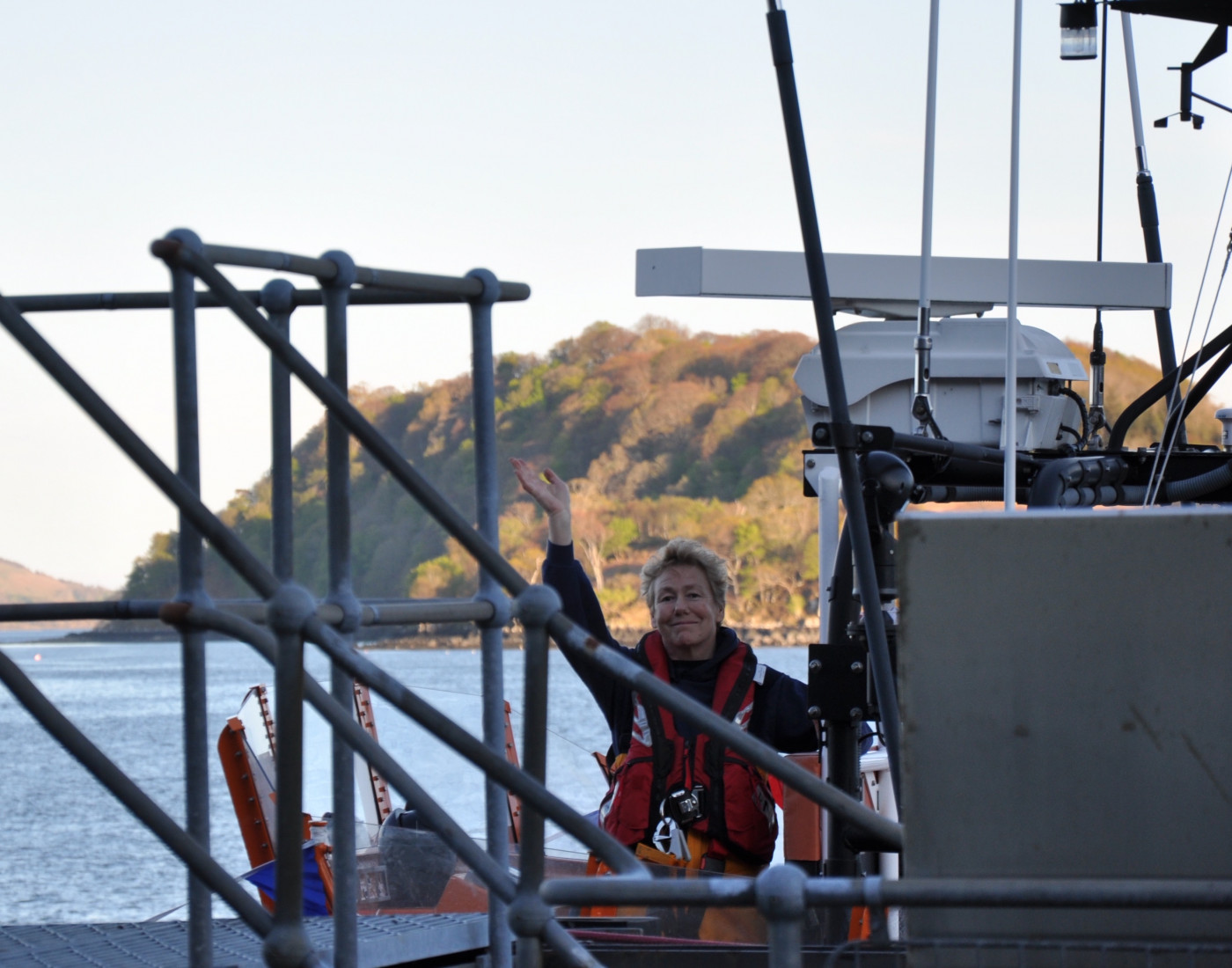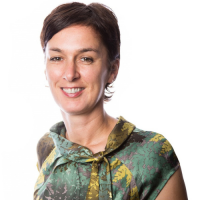The Royal National Lifeboat Institution was founded in 1844 and has since rescued 144,000 people. The charity currently has 248 lifeboat stations and lifeguards on more than 240 beaches. Its lifeboats are designed and built by the RNLI. In 1907, RNLI crew saved 456 people from the Suevic, when sixty RNLI crew rowed back and forth for sixteen hours to rescue people, including 70 babies. The RNLI is the most public face of maritime safety: everyone knows the big orange boat. But what is it like to go out on shout after shout (in the RNLI, shouts are called call-outs) in all weathers and at all hours, and for your life to be restricted for as long as you remain on active service? What do you sacrifice?
Jane Griffiths volunteered for the RNLI in Tobermory on the Isle of Mull for 19 years. She started as crew and in 2004 became the first female coxswain (skipper) of an all-weather lifeboat. She is an oceanographer and marine environmental scientist currently working on acoustic surveys of dolphins. During her service, she went out on 67 rescues and the lifeboat saved the lives of 48 people from shipwreck. She left the crew in 2016.

I just stopped basically because I was unavailable – I don’t live in Tobermory any more – and also I was getting on, but I don't like to think of it as retiring because they don't have a retiring age.
I’ve lived on Mull for about 35 years and I’d moved up to the north end where the lifeboat is based. I was diving then and I met somebody who was on the crew and realized I could join. I thought this would be a great thing to join and mainly to get to know the community better. And also go out on the lifeboat.
Yes. What everybody who works on the lifeboat says is that the great thing is being part of a team.
Tobermory is big for Mull but it only has about 1000 people. And to get people who are available 24 hours is quite hard. You need six people to take the lifeboat out and they like to keep the crew at upwards of 20, 25. There is a full-time paid coxswain and a full-time paid mechanic now. Everyone else is on call.
Just about. I’m sure it was to tow something. That was the most common thing we did. We could get the lifeboat out in three minutes, that’s remarkable. The lifeboat is the largest boat in the fleet, it’s the Severn class.
We’re the most westerly point of the mainland. The weather can get pretty rough out there. There’s another lifeboat at Barra and one at Oban and at Isla, but we have a pretty big patch.
I got trained up through working as crew, until I was relief coxswain. Whenever there was a big football match on, I was on. I used to do cover every other weekend. It’s quite hard: you have to be within two miles of the lifeboat because you have to get there in five minutes. And carrying a pager is a very tying thing.
Yes, but I’m not a runner so it was embarrassing, I’d end up walking. But there’s always a lot of running and speeding.
It’s always difficult to go out at two in the morning in the winter, in the dark. You can be a bit apprehensive. But that’s a healthy thing.
You have to trust each other. It doesn’t matter if somebody is poor at a particular skill, say someone is rubbish at throwing a line. So long as you know, and they know. You have to know everyone’s strong and weak points. Then you can build a team. So you have to trust people to know their own abilities.
When I was training to be coxswain I got a good talking-to by the RNLI. They said, “you have to stop being nice. Just tell them what to do.” It’s a skill to be decisive. You have to make a decision even if it’s not the best decision. So I think one of the key things of being a good leader is being able to make that decision and take everybody else with you.
I work offshore a lot and I’ve worked in male-dominated environments. The RNLI is a large cautious institution and can be slow to change. But I was trained up by my crew, they put me there, and the great thing I found about the RNLI was that the crew supported me and took criticism of me personally. That doesn’t often happen because often you are undermined when you are in a minority as a female. Luckily the lifeboat stations have a lot of autonomy and Tobermory has always had a reputation of having women on the crew. I was always walking in the footsteps of those who had managed to cement the position of women.
Probably the limited population and the timing of the station, which opened in the 1970s or 1980s. It really depends on the culture of the station.
The worst thing is usually when you feel sick. That’s probably why I ended up being a coxswain in the first place because if you feel sick the best place to be is at the helm of the boat.
We’ve had a lot of long shouts where we’ve had to go out at night to tow. One of my very early shouts we had to tow a really large disabled fishing boat a considerable distance in bad weather for six or seven hours. But you have to have confidence in your boat. The longer I was a skipper, the more I understood what the boat can do. They’re very good boats. You can’t sink them. You can disable them, but they self-right.
Often the people we rescued, particularly if they were, say, a yacht with women on board, they would be so pleased to see a woman. Even a lot of the men were very pleased to see a woman. It kind of reassured them no end that they were going to be looked after even better. People were always extremely grateful. This big orange boat looms out of the seas to come and save your life. People are often in a very vulnerable state. And, just the aura of confidence. People feel embraced by the aura of confidence, by the RNLI. That's why people love the RNLI. Because they really do feel that we saved their lives.

You’d expect me to say humans, but actually it’s the boat. Really you can't go out unless the boat's fit for the job, not when you're going to go out into anything to help someone. And you have the lives of all the other people on the boat to bear in mind as well. But whenever I was scared, all I had to do was step back and let somebody else who wasn't scared deal with that situation. For example when I was helming at night once. It’s very difficult at night to get your perspective. It often seems that the rocks are right there but someone is telling you to keep going at full speed. That’s quite difficult to do. All I'm saying is that it's easy to be disorientated, but you have to be able to acknowledge that you are disorientated so you can do something about it.
I do. I still can’t help giving people advice on how to do up their lifejacket properly.
-
Chapter 1
Chapter 1
-
Chapter 2
Chapter 2
-
Chapter 3
Chapter 3
-
Chapter 4
Chapter 4
-
Chapter 5
Chapter 5
-
Chapter 6
Chapter 6
-
Chapter 7
Chapter 7
-
Chapter 8
Chapter 8
-
Chapter 9
Chapter 9
-
Chapter 10
Chapter 10
-
Chapter 11
Chapter 11
-
Chapter 12
Chapter 12
-
Chapter 13
Chapter 13
-
Chapter 14
Chapter 14
-
Chapter 15
Chapter 15
-
Chapter 16
Chapter 16
-
Chapter 17
Chapter 17
-
Chapter 18
Chapter 18
-
Chapter 19
Chapter 19




